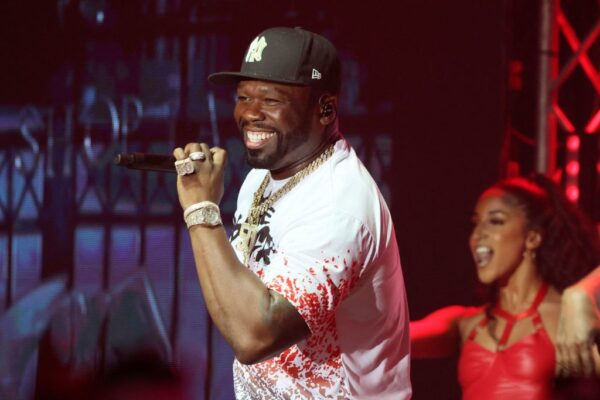Over the last 25 years, rapper 50 Cent has been working to redefine for a generation the face of the artist-mogul. Breaking on the scene during a time when making commercial deals was considered selling out, the Queens, New York, native was one of the few to use his stardom as a bargaining chip to cement him as a staple in corporate boardrooms and now one of the most bankable Hollywood showrunners.

However, the journey to being powerful has not been without some drastic dips and turns. There have been times when, the “Get Rich or Die Tryin’” rapper with his estimated net worth of $40 million to $50 million, has been on the brink of losing it all. However, the hustler from 137th and Guy Brewer Blvd. — the rough Southside Jamaica, Queens — and recent Emmy winner refused to give up, and has managed to keep finding his way to the top.
Get Rich or Die Tryin’
50 Cent was born into the game of slick-talking, scheming, and hustling. His mother, Sabrina Jackson, was a drug dealer. She was murdered when 50 was only eight years old. By the time he was 12, 50 was selling drugs in his South Jamaica neighborhood, ruling hs part of the streets under the nickname “Boo Boo.”
Over a few years, 50 Cent went from street hustling and robbing people, getting shot nine times, to being one of the biggest selling artists of the early 2000s.
In his early 20s, he met hip-hop legend Jam Master Jay of Run-DMC and transitioned his life into music, surrendering one hustle for the next, and, by 1998, 50 was signed to Trackmasters/Columbia Records where he secured representation under Violator Management with Chris Lighty.
With Lighty and after he was dropped from Columbia, he was able to secure a recording contract with Interscope, under Eminem and Dr. Dre.
In 2003, his debut project “Get Rich or Die Tryin’” was the second-greatest selling album of the year and since its release has sold over 12 million units. His sophomore project, “The Massacre,” was the seventh-greatest seller of the year and has sold over eight million units.
With the success of these projects, he went from struggling to pay $800 rent to buying Mike Tyson’s massive home in Farmington, Connecticut, for $4.4 million in 2003.
Later, he would found G-Unit Records, launching the careers of artists like Tony Yayo, Lloyd Banks, Olivia and Young Buck. He also once signed Mobb Deep and even served, years later, as the executive producer on Pop Smoke’s latest project.
Mogul in the Making
But it wasn’t just music making him rich. With his management, 50 Cent launched his own sneaker, “G6,” from the “G-Unit Collection at Rbk” in November 2003. In a 2012 interview with Power 106’s Big Boy, he said his sneaker outsold Jay-Z’s S. Carter, which dropped around the same time, grossed “about $80 million” overall for the brand and the artist.
After the sneaker, the rapper as a health nut told his manager he wanted to get into bottled water. He allegedly noticed the difference between the prices in the stores and believed he could find a fit in this space. Lighty connected with Rohan Oza, a former Coca-Cola executive, and linked the two with Glaceau, Vitaminwater’s parent company. They negotiated a 10 percent stake in his own brand of beverage, Formula 50.
In the marketing, the rapper drank the bottle of water in his Reebok commercial for his sneaker, which sent the sales through the roof.
According to Trapital, “Vitaminwater sales grew from $100 million in 2004 to $700 million in 2007. In May 2007, Coca-Cola bought Glaceau for $4.1 billion, and 50 Cent got paid.”
He reportedly walked away with $100 million based on this deal, however, the actual terms have never been made public.
Bankruptcy
After paying over $22 million in debt, in 2017, a federal judge discharged 50 Cent’s bankruptcy case. But how did the multi-platinum rapper get to a place where he couldn’t pay?
Three years after Lighty, his former manager, transitioned in 2012, 50 found himself in a tsunami worth of bills and legal troubles.
He had numerous failed businesses and owed a lot of people a lot of money. One person was a woman who was awarded a $7 million settlement in 2015, after proving the artist posted a sex tape of hers on the internet.
But like any hustler, he figured out how to surf his financial wave, taming it so that it worked for him. In 2015, the artist, whose real name is Curtis Jackson, filed for Chapter 11 reorganization, totaling his debt at $36 million and his assets being less than $20 million.
According to National Bankruptcy, Chapter 11 of the Bankruptcy Code allows individuals to seek relief from their debt as they reorganize their companies or financial lives, affording them the grace to pay their creditors over a three-to-five-year time period.
The grace requires the person filing to be honest about their financial status.
This was almost compromised when, in 2016, 50 took to Instagram, posting pictures of him lounging in bed with money all around him and spelling out “broke” in stacks of bills. Upon being made aware of the post, Judge Ann Nevins, the Connecticut judge over his bankruptcy case, confronted the rapper, asking if the money was a declaration of his assets.
Fifty told the judge the money was “prop money,” saying, “Just because I am photographed in or next to a certain vehicle, wearing an article of clothing, holding a product, sitting next to what appears to be large sums of money or modeling expensive pieces of jewelry does not mean that I own everything in those photos.”
He added, “Since the explosion of social media, I have maintained a strong social media presence that is consistent with the public persona of ‘50 Cent.’”
He paid off the five-year bankruptcy obligation earlier than expected with $8.7 million of his own cash and $13.65 from a settlement he received from a legal malpractice lawsuit.
Rebirth
Years after he emerged from his bankruptcy, 50 Cent entered Hollywood as a producer. Previously, he made waves as an actor (“Get Rich or Die Tryin,’” “Entourage,” “All Things Fall Apart”), but now he would be behind the scenes as a showrunner.
In 2018, he inked a lucrative multi-series, four-year deal, reportedly worth up to $150 million, with the Starz network for his “Power” universe, a complicated web of stories connected to James “Ghost” St. Patrick.
According to Zack O’Malley Greenburg, Forbes’ senior editor, “50 Cent made around $300 million in two years. He has always been really good at profiting off whatever his situation is. He even marketed getting shot nine times.”
In addition to television, 50 has also tapped into the adult beverages space with his two spirit brands: Le Chemin du Roi and Branson Cognac. He distributes the brands through his Sire Spirits distribution company.
His first effort was a partnership with Effen Vodka, but he reportedly sold his $60 million stake in the company.
Between bestselling books, investments, real estate, stocks, and more, within roughly one decade, he reportedly flipped his bankruptcy to a gold mine.




